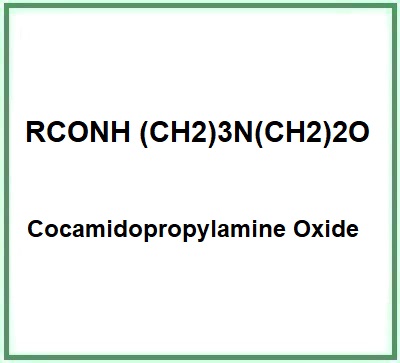Cocamidopropylamine oxide (often shortened to CAPAO) is a chemical compound, a tertiary amine oxide, generally obtained from coconut oil.
The name describes the structure of the molecule
- Coca- refers to the fatty acid origin from which it is derived, often coconut oil.
- -midopropyl indicates the presence of a portion derived from the reaction between the fatty acid and amine.
- -amine oxide indicates that the molecule has an amine oxide functionality.
Description of raw materials used in production
- Coconut oil or coconut fatty acids: Used as raw materials to derive the amide.
- Dimethylamino propylamine: This amine is used to react with the coconut fatty acids to form the intermediary compound.
- Hydrogen peroxide (H2O2): Used in the oxidation reaction to convert the amine to amine oxide.
Synthesis process
- Amidation: Fatty acids derived from coconut oil react with dimethylamino propylamine to form a cocamidopropylamine.
- Oxidation: The cocamidopropylamine is subsequently oxidized using hydrogen peroxide to form cocamidopropylamine oxide.
- Purification: The final product is purified to remove any impurities.
What it is used for and where it is used
Cosmetics
Cleansing agent. Ingredient that cleanses skin without exploiting the surface-active properties that produce a lowering of the surface tension of the stratum corneum.
Surfactant - Foam booster. It has the effect of introducing gas bubbles into the water and affects the cleaning process by helping to spread the cleanser. Since sebum has an inhibiting effect on the bubble, more foam is produced in the second shampoo.
Hair conditioning agent. A significant number of ingredients with specific and targeted purposes may co-exist in hair shampoo formulations: cleansers, conditioners, thickeners, matting agents, sequestering agents, fragrances, preservatives, special additives. However, the indispensable ingredients are the cleansers and conditioners as they are necessary and sufficient for hair cleansing and manageability. The others act as commercial and non-essential auxiliaries such as: appearance, fragrance, colouring, etc. Hair conditioning agents have the task of increasing shine, manageability and volume, and reducing static electricity, especially after treatments such as colouring, ironing, waving, drying and brushing. They are, in practice, dispersants that may contain cationic surfactants, thickeners, emollients, polymers. The typology of hair conditioning agents includes: intensive conditioners, instant conditioners, thickening conditioners, drying conditioners. They can perform their task generally accompanied by other different ingredients.
Surfactant - Hydrotrope (solubilizing agents). It has the property of facilitating the miscibility of other compounds that are poorly soluble in water and does not form micelles in the solubilisation process, even with a chemical reaction of complexation or molecular aggregation. The two fundamental solubilisation factors are the hydrotropic-solute association mediated by the depression of water activity and ionic dissociation.
Surfactant - Cleansing agent. Cosmetic products used to cleanse the skin utilise the surface-active action that produces a lowering of the surface tension of the stratum corneum, facilitating the removal of dirt and impurities.
The percentage of use varies from 0.07% to 4%
PH: 6.0 to 8.0
Applications:
- Personal Care Products: CAPAO is often used in shampoos, conditioners, body washes, and facial cleansers. Its mild nature makes it especially suitable for baby products and products for sensitive skin.
- Cleaning Products: Apart from personal care, CAPAO can be found in household cleaning products, including dishwashing liquids and hard surface cleaners.
- Foam Booster: It enhances foam stability and volume, making it a common choice for products that require rich lather.
- Thickening Agent: It can also act as a thickener in cosmetic and personal care formulations.
Advantages:
- Mildness: It's known to be gentle on the skin, reducing the potential for irritation.
- Compatibility: CAPAO is compatible with anionic, cationic, and nonionic surfactants, making it versatile in formulation.
- Stability: It's stable in both acidic and alkaline conditions, broadening its application range.
- Compatible with anionic, cationic, amphoteric and nonionic surfactants and improve the combination property.
Cocamidopropylamine oxide studies
Molecular Formula: RCONH (CH2)3N(CH2)2O R: Coco alkyl
UNII: M4SL82J7HK
CAS: 68155-09-9
EC Number: 268-938-5
Synonyms:
- Amides, coco, N-(3-(dimethylamino)propyl), N-oxide
- N-(Cocoamidopropyl)-N,N-dimethylamine, oxide
- Cocoamido-3-propyldimethylamine oxide
- 3-(N,N-Dimethylamino)propyl cocoamido amine oxide
- N,N-Dimethyl-N-(3-cocamidopropyl)amine oxide
- N,N-Dimethyl-N-(3-(coconut oil alkyl)amidopropyl)amine oxide
- Coco amides, N-(3-(dimethylamino)propyl), N-oxide
- N-(3-(Dimethylamino)propyl)coco amides-N-oxide
- Amides, coco, N-(3-(dimethylamino)propyl), N-oxides
- Cocamidopropyldimethylamine oxide
- 3-Cocoamidopropyl dimethylamine oxide
- N-(3-(Dimethylamino)propyl) coco amides N-oxides
![]() Cocamidopropylamine Oxide
Cocamidopropylamine Oxide 

